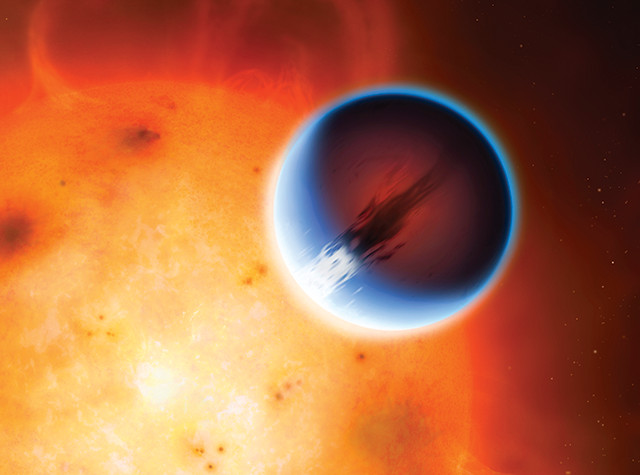
by Timothy Oleson Thursday, April 21, 2016

Exoplanet HD 189733b, a so-called hot Jupiter, transits across the face of its home star in this artist's rendition. Researchers have found evidence of a high-velocity equatorial wind belt that travels around the planet. Credit: Mark A. Garlick/University of Warwick.
Imagine the planetary lovechild of Jupiter and Mercury — but even larger than the former (usually) and much closer to the sun than the latter — and a picture will emerge of so-called “hot Jupiters,” a class of huge, sizzling exoplanets that typically take just a few Earth days to orbit their parent stars. Not much is known about these mysterious worlds, only recognized since the mid-1990s, but new research is helping improve our understanding.
In a study published in Astrophysical Journal Letters, Tom Louden and Peter Wheatley of the University of Warwick in England report “the first-ever weather map from outside of our solar system,” Louden said in a statement. The pair analyzed spectroscopic data from the High Accuracy Radial velocity Planet Searcher (HARPS) in Chile collected as a hot Jupiter called HD 189733b transited in front of its home star, which is about 63 light-years from Earth. Based on changes in how much light from the star was absorbed by sodium in different parts of the planet’s atmosphere during the transit, the researchers determined that a belt of wind travels west to east around the planet’s equator at speeds of about 8,700 kilometers per hour, roughly 20 times faster than the fastest gust ever recorded on Earth. “As we develop the technique further we will be able to study wind flows in increasing detail and make weather maps of smaller planets. Ultimately, this technique will allow us to image the weather systems on Earth-like planets,” Wheatley said.
Meanwhile, in another study, researchers looked for signs of water in the atmospheres of HD 189733b as well as nine other hot Jupiter exoplanets by analyzing a wide range of light wavelengths in spectra collected by the Hubble and Spitzer space telescopes. Previous work looking at narrower windows of light had suggested that hot Jupiters have low atmospheric abundances of water simply because the planets formed from materials already depleted in water. However, weak water absorption signals in spectra could also result from haze or clouds that scatter wavelengths of light characteristic of water, thus obscuring that light from telescopes. David Sing of the University of Exeter in England and colleagues found that the planets they studied “exhibit a continuum from clear to cloudy atmospheres.” Water absorption signals in the spectral data were stronger in the case of planets with clear atmospheres, and vice versa, which, they reported in Nature, “suggests that primordial water depletion during [hot Jupiter] formation is unlikely and that clouds and hazes are the cause of weaker spectral signatures.”
© 2008-2021. All rights reserved. Any copying, redistribution or retransmission of any of the contents of this service without the expressed written permission of the American Geosciences Institute is expressly prohibited. Click here for all copyright requests.